江苏省常州市西夏墅中学高中英语 Unit2 Language Project教学设计1 牛津译林版必修3
- 格式:doc
- 大小:91.00 KB
- 文档页数:3
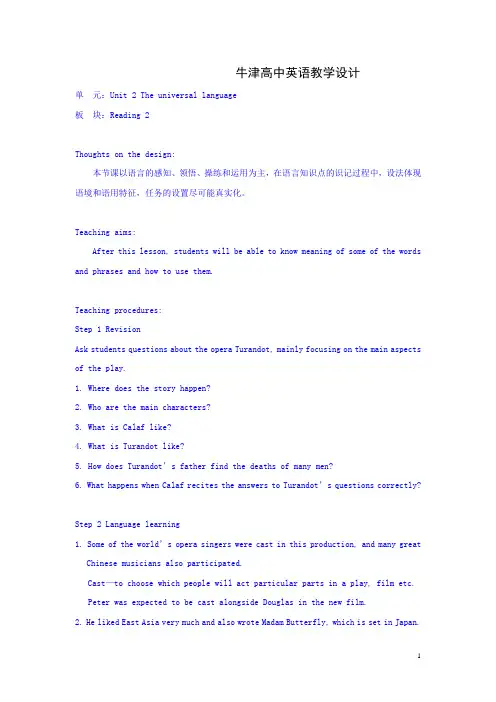
牛津高中英语教学设计单元:Unit 2 The universal language板块:Reading 2Thoughts on the design:本节课以语言的感知、领悟、操练和运用为主,在语言知识点的识记过程中,设法体现语境和语用特征,任务的设置尽可能真实化。
Teaching aims:After this lesson, students will be able to know meaning of some of the words and phrases and how to use them.Teaching procedures:Step 1 RevisionAsk students questions about the opera Turandot, mainly focusing on the main aspects of the play.1. Where does the story happen?2. Who are the main characters?3. What is Calaf like?4. What is Turandot like?5. How does Turandot’s father find the deaths of many men?6. What happens when Calaf recites the answers to Turandot’s questions correctly?Step 2 Language learning1. Some of the world’s opera singers were cast in this production, and many greatChinese musicians also participated.Cast—to choose which people will act particular parts in a play, film etc.Peter was expected to be cast alongside Douglas in the new film.2. He liked East Asia very much and also wrote Madam Butterfly, which is set in Japan.be set in—if a film, play, story etc. is set in a particular place or period, the action takes place thereThe novel is set in France.3. Those who cannot answer all three riddles, however, will be condemned to death. be condemned to death—to give someone a severe punishment after deciding they are guilty of a crimeHe was found guilty and condemned to death.4. This means that few men would dare to ask for her hand in marriage.ask for one’s hand in marriage—ask sb. to get marriedAfter they fell in love with each other for nine years, John asked for Mary’s hand in marriage.5. However, although he would like to, he cannot break his promise and must allow Turandot to do as she wishes.break one’s promise—not keep one’s promiseThe government failed to keep its promise of lower taxes.= The government broke its promise.Have you ever broken your promise? When was that?6-7. Shortly afterwards, another prince, Calaf, falls in love with Turandot at first sight and decides to solve the riddles so that he can marry her.The report claims that when women fall in love, they tend to eat more.They meet and fall in love with each other during the Second World War.At first sight these deals might not appear to have much to do with each other.8. The story then takes on a classic love triangle between Calaf, Turandot and Liu. take on—to begin to have a particular quality, appearance, etc.After years of reform and opening-up policy, our country __________________ When the Prime Minister began to talk about the economic situations in the country, his voice ____________________.9. so Turandot seizes Calaf’s father and Li u, and demands that they tell her Calaf’s name or they will be beaten.demand to know/see/have etc. somethingI demand to know w hat’s going on.demand thatThey demanded that the military government free all political prisoners. demand something of somebodyIt seemed that no matter what she did, more was demanded of her.“Where are you going?” she demanded angrily.10. Liu claims that she alone knows the name, but resists telling her because she loves him.Resist—to stop yourself from having something that you like very much cannot resist (doing) somethingI just can’t resist chocolate.She can never resist buying new shoes.It is hard/difficult/impossible to resist somethingIt’s hard to resist an invitation like that.resist the temptation/urge to do somethingShe resisted the temptation to laugh.11. Calaf scolds Turandot for not being more merciful.scold sb. for doing sth.Don’t scold her for being silly.12. … it has been transformed into the spot for a beautiful and sad love story. transform—to completely change the appearance or character of sth, esp. so that it is better.The company has been transformed from a family business to a multi-million-pound one.Is there an event that has transformed your life?Pieces of Titanic were transformed into luxury watches.Step 3 Follow-up Activity (PPT 13)Write a short story within 80 words, using five of the new words and expressions.Step 4 Homework1. Review what has been learned in today’s class.2. Finish the exercises on Page108.本节课首先复习课文内容,以免使得词汇学习太过突兀。
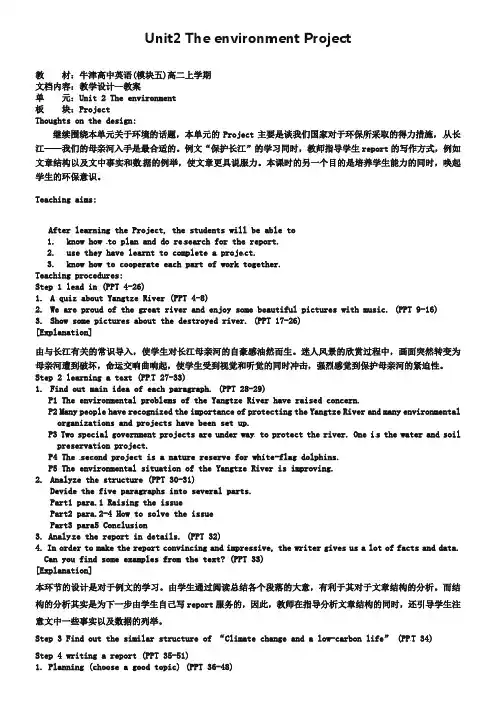
Unit2 The environment Project教材:牛津高中英语(模块五)高二上学期文档内容:教学设计—教案单元:Unit 2 The environment板块:ProjectThoughts on the design:继续围绕本单元关于环境的话题,本单元的Project主要是谈我们国家对于环保所采取的得力措施,从长江——我们的母亲河入手是最合适的。
例文“保护长江”的学习同时,教师指导学生report的写作方式,例如文章结构以及文中事实和数据的例举,使文章更具说服力。
本课时的另一个目的是培养学生能力的同时,唤起学生的环保意识。
Teaching aims:After learning the Project, the students will be able to1.know how to plan and do re search for the report.e they have learnt to complete a proje ct.3.know how to cooperate each part of work together.Teaching procedures:Step 1 lead in (PPT 4-26)1. A quiz about Yangtze River (PPT 4-8)2.We are proud of the great river and enjoy some beautiful pictures with music. (PPT 9-16)3.Show some pictures about the destroyed river. (PPT 17-26)[Explanation]由与长江有关的常识导入,使学生对长江母亲河的自豪感油然而生。
迷人风景的欣赏过程中,画面突然转变为母亲河遭到破坏,命运交响曲响起,使学生受到视觉和听觉的同时冲击,强烈感觉到保护母亲河的紧迫性。
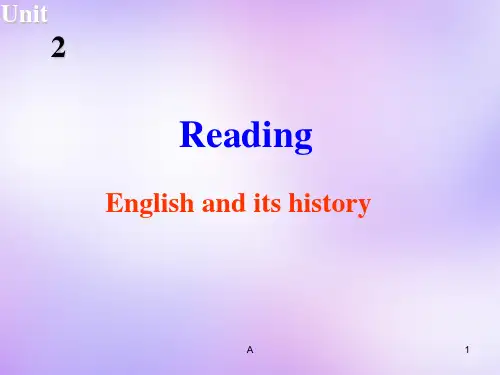
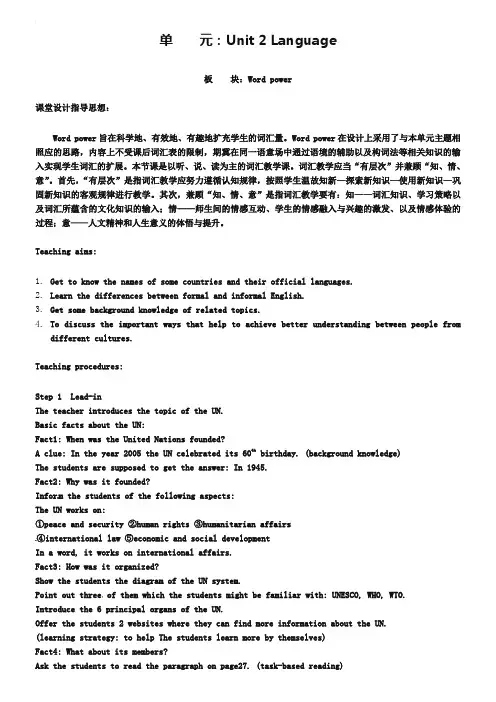
单元:Unit 2 Language板块:Word power课堂设计指导思想:Word power旨在科学地、有效地、有趣地扩充学生的词汇量。
Word power在设计上采用了与本单元主题相照应的思路,内容上不受课后词汇表的限制,期冀在同一语意场中通过语境的辅助以及构词法等相关知识的输入实现学生词汇的扩展。
本节课是以听、说、读为主的词汇教学课。
词汇教学应当“有层次”并兼顾“知、情、意”。
首先,“有层次”是指词汇教学应努力遵循认知规律,按照学生温故知新—探索新知识—使用新知识—巩固新知识的客观规律进行教学。
其次,兼顾“知、情、意”是指词汇教学要有:知——词汇知识、学习策略以及词汇所蕴含的文化知识的输入;情——师生间的情感互动、学生的情感融入与兴趣的激发、以及情感体验的过程;意——人文精神和人生意义的体悟与提升。
Teaching aims:1.Get to know the names of some countries and their official languages.2.Learn the differences between formal and informal English.3.Get some background knowledge of related topics.4.To discuss the important ways that help to achieve better understanding between people fromdifferent cultures.Teaching procedures:Step 1 Lead-inThe teacher introduces the topic of the UN.Basic facts about the UN:Fact1: When was the United Nations founded?A clue: In the year 2005 the UN celebrated its 60th birthday. (background knowledge)The students are supposed to get the answer: In 1945.Fact2: Why was it founded?Infor m the students of the following aspects:The UN works on:①peace and security ②human rights ③humanitarian affairs④international law ⑤economic and social developmentIn a word, it works on international affairs.Fact3: How was it organized?Show the students the diagram of the UN system.Point out three of them which the students might be familiar with: UNESCO, WHO, WTO.Introduce the 6 principal organs of the UN.Offer the students 2 websites where they can find more information about the UN.(learning strategy: to help The students learn more by themselves)Fact4: What about its members?Ask the students to read the paragraph on page27. (task-based reading)Task: Answer the following questions:① How many countries are members of the UN? (191)② Can you give me some examples of the member sta tes? (China, France, etc.)③ How many languages are spoken in the world today? (About 6000)Check the answers and gi ve more information.【设计说明】结合课文中的信息,为学生了解联合国提供了一系列的背景知识:联合国建立的时期、目的、组成、以及成员国和使用语言等等。
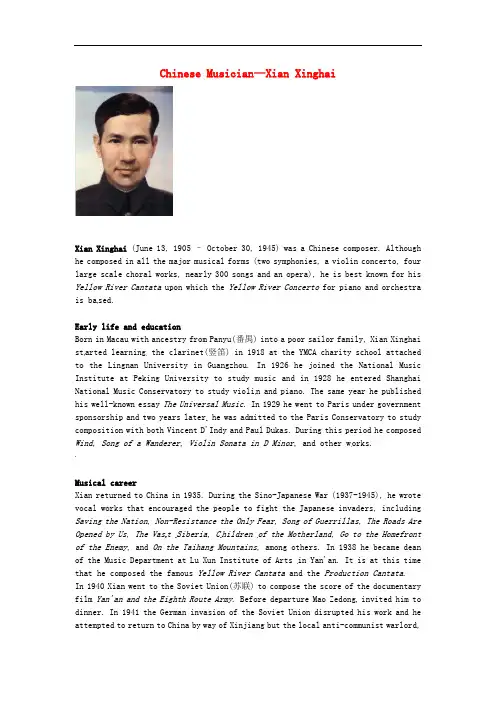
Chinese Musician—Xian XinghaiXian Xinghai (June 13, 1905 – October 30, 1945) was a Chinese composer. Although he composed in all the major musical forms (two symphonies, a violin concerto, four large scale choral works, nearly 300 songs and an opera), he is best known for his Yellow River Cantata upon which the Yellow River Concerto for piano and orchestra is ba sed.Early life and educationBorn in Macau with ancestry from Panyu(番禺) into a poor sailor family, Xian Xinghai st arted learning the clarinet(竖笛) in 1918 at the YMCA charity school attached to the Lingnan University in Guangzhou. In 1926 he joined the National Music Institute at Peking University to study music and in 1928 he entered Shanghai National Music Conservatory to study violi n and piano. The same year he published his well-known essay The Universal Music. In 1929 he went to Paris under government sponsorship and two years later he was admitted to the Paris Conservatory to study composition with both Vincent D'Indy and Paul Dukas. During this period he composed Wind, Song of a Wanderer, Violin Sonata in D Minor, and other w orks.Musical careerXian returned to China in 1935. During the Sino-Japanese War (1937-1945), he wrote vocal works that encouraged the people to fight the Japanese invaders, including Saving the Nation, Non-Resistance the Only Fear, Song of Guerrillas, The Roads Are Opened by Us, The Vas t Siberia, C hildren of the Motherland, Go to the Homefront of the Enemy, and On the Taihang Mountains, among others. In 1938 he became dean of the Music Department at Lu Xun Institute of Arts in Yan'an. It is at this time that he composed the famous Yellow River Cantata and the Production Cantata.In 1940 Xian went to the Soviet Union(苏联) to compose the score of the documentary film Yan'an and the Eighth Route Army. Before departure Mao Zedong invited him to dinner. In 1941 the German invasion of the Soviet Union disrupted his work and he attempted to return to China by way of Xinjiang but the local anti-communist warlord,Sheng Shicai, blocked the way and he got stranded in Alma Ata, Kazakhstan. It was here that he comp osed the symphonies Liberation of the Nation and Sacred War, and the suites Red All Over the River and Chinese Rhapsody for winds and strings. He developed pulmonary tuberculosis due to overwork and malnutrition. After the war, Xinghai went back to Moscow for medical treatment but could not be completely cured and died in O ctober, 1945 in a hospital nearby the Moscow Kremlin at the age of 40.。
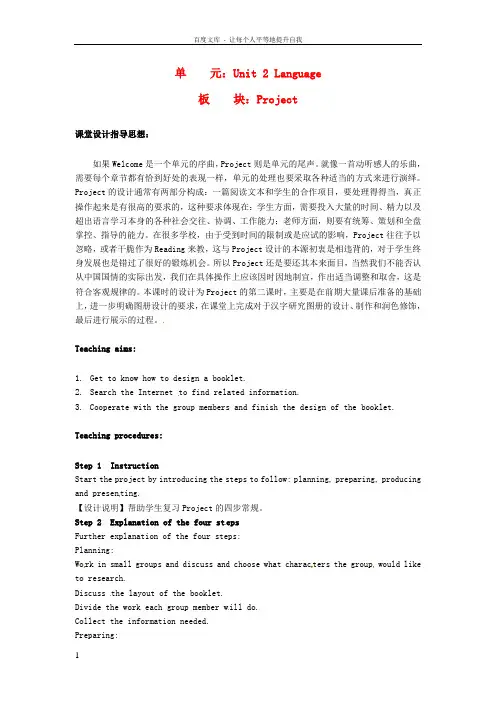
单元:Unit 2 Language板块:Project课堂设计指导思想:如果Welcome是一个单元的序曲,Project则是单元的尾声。
就像一首动听感人的乐曲,需要每个章节都有恰到好处的表现一样,单元的处理也要采取各种适当的方式来进行演绎。
Project的设计通常有两部分构成:一篇阅读文本和学生的合作项目,要处理得得当,真正操作起来是有很高的要求的,这种要求体现在:学生方面,需要投入大量的时间、精力以及超出语言学习本身的各种社会交往、协调、工作能力;老师方面,则要有统筹、策划和全盘掌控、指导的能力。
在很多学校,由于受到时间的限制或是应试的影响,Project往往予以忽略,或者干脆作为Reading来教,这与Project设计的本源初衷是相违背的,对于学生终身发展也是错过了很好的锻炼机会。
所以Project还是要还其本来面目,当然我们不能否认从中国国情的实际出发,我们在具体操作上应该因时因地制宜,作出适当调整和取舍,这是符合客观规律的。
本课时的设计为Project的第二课时,主要是在前期大量课后准备的基础上,进一步明确图册设计的要求,在课堂上完成对于汉字研究图册的设计、制作和润色修饰,最后进行展示的过程。
Teaching aims:1.Get to know how to design a booklet.2.Search the Internet to find related information.3.Cooperate with the group members and finish the design of the booklet.Teaching procedures:Step 1 InstructionStart the project by introducing the steps to follow: planning, preparing, producing and presen ting.【设计说明】帮助学生复习Project的四步常规。
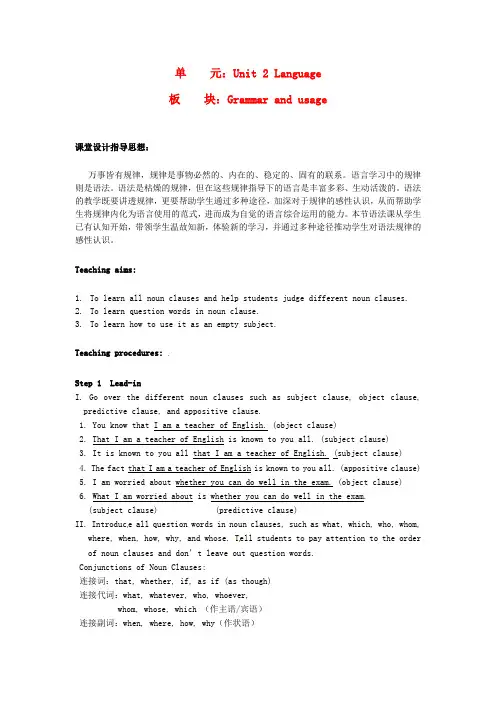
单元:Unit 2 Language板块:Grammar and usage课堂设计指导思想:万事皆有规律,规律是事物必然的、内在的、稳定的、固有的联系。
语言学习中的规律则是语法。
语法是枯燥的规律,但在这些规律指导下的语言是丰富多彩、生动活泼的。
语法的教学既要讲透规律,更要帮助学生通过多种途径,加深对于规律的感性认识,从而帮助学生将规律内化为语言使用的范式,进而成为自觉的语言综合运用的能力。
本节语法课从学生已有认知开始,带领学生温故知新,体验新的学习,并通过多种途径推动学生对语法规律的感性认识。
Teaching aims:1.To learn all noun clauses and help students judge different noun clauses.2.To learn question words in noun clause.3.To learn how to use it as an empty subject.Teaching procedures:Step 1 Lead-inI. Go over the different noun clauses such as subject clause, object clause, predictive clause, and appositive clause.1. You know that I am a teacher of English. (object clause)2. That I am a teacher of English is known to you all. (subject clause)3. It is known to you all that I am a teacher of English. (subject clause)4. The fact that I am a teacher of English is known to you all. (appositive clause)5. I am worried about whether you can do well in the exam. (object clause)6. What I am worried about is whether you can do well in the exam.(subject clause) (predictive clause)II. Introduc e all question words in noun clauses, such as what, which, who, whom, where, when, how, why, and whose. Tell students to pay attention to the order of noun clauses and don’t leave out question words.Conjunctions of Noun Clauses:连接词:that, whether, if, as if (as though)连接代词:what, whatever, who, whoever,whom, whose, which (作主语/宾语)连接副词:when, where, how, why(作状语)【设计说明】因为这是语法名词性从句的second period,所以一开始先对上一单元语法的first period进行简单复习与回顾:名词性从句的种类及语法成分,然后对名词性从句的连词进行归类,过渡到本课内容:由疑问词引导的名词性从句。
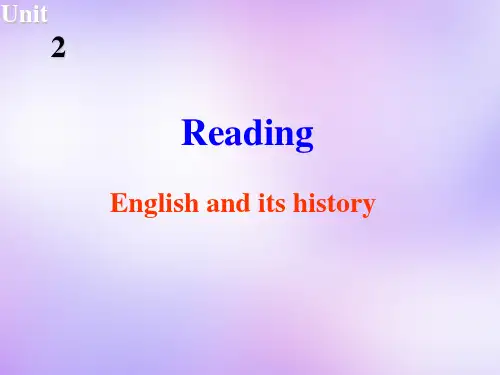
单元:Unit 2 Language
板块:Project
课堂设计指导思想:
如果Welcome是一个单元的序曲,Project则是单元的尾声。
就像一首动听感人的乐曲,需要每个章节都有恰到好处的表现一样,单元的处理也要采取各种适当的方式来进行演绎。
Project的设计通常有两部分构成:一篇阅读文本和学生的合作项目,要处理得得当,真正操作起来是有很高的要求的,这种要求体现在:学生方面,需要投入大量的时间、精力以及超出语言学习本身的各种社会交往、协调、工作能力;老师方面,则要有统筹、策划和全盘掌控、指导的能力。
在很多学校,由于受到时间的限制或是应试的影响,Project往往予以忽略,或者干脆作为Reading来教,这与Project设计的本源初衷是相违背的,对于学生终身发展也是错过了很好的锻炼机会。
所以Project还是要还其本来面目,当然我们不能否认从中国国情的实际出发,我们在具体操作上应该因时因地制宜,作出适当调整和取舍,这是符合客观规律的。
本课时的设计为Project的第一课时,主要是侧重于文本的处理。
对于Project的文本,我们在实际操作中达成了这样的认识:文本是用以阅读的,但是不同于Reading的阅读,Project的文本阅读不是单单以获取信息、了解文本为目的的,它的存在是以阅读为基础,为下一课时的图册文本设计提供信息与蓝本。
Teaching aims:
1.Get to know the development of Chinese characters.
2.Get informed of the formation of Chinese characters.
3.Learn to explain the Chinese character by the way it forms.
Teaching procedures:
Step 1 Lead-in
Show the students a picture of a running horse. Simplify the image using lines. And explain how it became the origin of the character “马”. Introduce the t opic “The development of Chinese characters”.
【设计说明】作为文本阅读的导入,主要实现:挑动学生的学习兴趣,激发学生的学习热情,自然而然地引至主题。
Step 2 Sk imming
Skim the text and discuss the structure of the text between partners. Think about how many parts we can divide the whole text into.
【设计说明】通过快速阅读掌握文本的结构划分,对于文本实现整体性的粗线条把握。
Step 3 Listening
Listen to the text and summarize the main idea for each part.
【设计说明】在文本划分基础上概括每部分的总体大意。
Step 4 Intensive reading
Part1
What makes the Chinese language differ from many Western languages?
The Chinese language differs from many Western languages in that it uses characters which stand for ideas, objects or deeds instead of an alphabet. And Chinese words are formed by combining different characters.
Part 2
Who is said to have invented Chinese writing?
Cang Jie.
Give a short introduction of Cang Jie.
仓颉也称苍颉,是传说为黄帝的史官,汉字的创造者。
传说中仓颉生有“双瞳四目”。
目有重瞳者,中国史书上记载只有三个人,虞舜、仓颉、项羽。
虞舜是禅让的圣人,孝顺的圣人,而仓颉是文圣人,项羽则是武圣人。
What fired his idea of inventing Chinese characters?
Tracks of animals in the snow.
Part 3
How are Chinese characters formed?
1. drawings of physical objects-pictographs (象形)
(Show students a picture of examples of development of pictographs.)
(More pictographs a re given for students to match with their simplified charact ers.)
2. combine two or more elements together to expr ess ideas or directions and number s (会意)
The teacher expl ains some characters.
examples: 家(有房有猪)采(手采摘草本植物)尖(上小下大)旦(地平线上的太阳) More characters are given to the students. They are encouraged to use their imagination to explain them.
囚——人困于门中,伐——人持刀戈,仙——山中人,众——多人,男——田里的劳力,休——人倚木而息,明——日与月,鸣——鸟口之声,孬——不好,森——众木,炎——多火,本——木之根,末——木之梢,歪——不正
3. combine meaning and pronunciation-pictophonetic characters(形声)
The teacher gi ves examples: 砖编聆骂
Ask the students to have a discussion with the partner and try to find s ome more examples of pictophonetic characters.
Part 4
When were simplified Chinese characters introduced by the Chinese government? In the 1950s.
Where are simplified Chinese characters used?
In China’s mainland.
【设计说明】在掌握文本结构,主体大意的基础上,进行文本的精细阅读,目的是在理解
文本细节的基础上,为Project的图册设计进行素材的收集,写作结构的梳理。
Step 5 Reading
Re ad the second passage and answer the questions:
Who is Braille?
What happened to him when he was three years old?
How did he create his system?
What do you think of Braille and his system?
【设计说明】泛读更多关于文字发展的相关材料。
Step 6 Homework
Find more information on the Internet about the development of Chinese characters. 【设计说明】通过网络阅读,提高学生搜寻、定位、整合信息的能力,为下一课时的图册制作实现素材的积累。